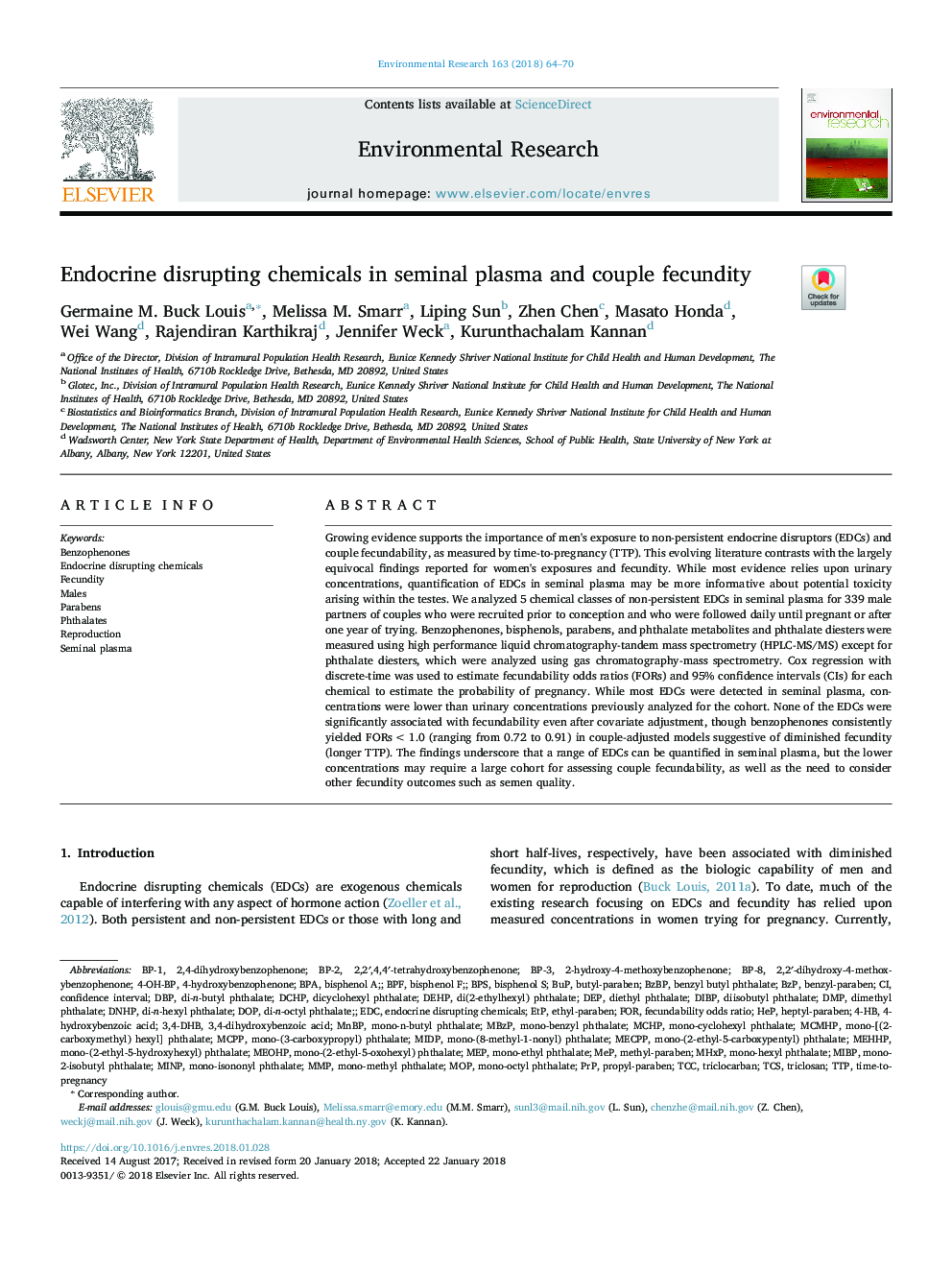| کد مقاله | کد نشریه | سال انتشار | مقاله انگلیسی | نسخه تمام متن |
|---|---|---|---|---|
| 8869082 | 1622540 | 2018 | 7 صفحه PDF | دانلود رایگان |
عنوان انگلیسی مقاله ISI
Endocrine disrupting chemicals in seminal plasma and couple fecundity
ترجمه فارسی عنوان
مواد شیمیایی خرابکار غدد درون ریز در پلاسمای سمی و باروری زن و شوهر
دانلود مقاله + سفارش ترجمه
دانلود مقاله ISI انگلیسی
رایگان برای ایرانیان
کلمات کلیدی
2,2′-dihydroxy-4-methoxybenzophenonedi-n-butyl phthalateBzBPBP-3BPABUPBPFHEPdi-n-octyl phthalateDnHPDCHPdi-n-hexyl phthalateBPSBP-1BP-2MCHPMIDP2,2′,4,4′-tetrahydroxybenzophenonemono-(3-carboxypropyl) phthalate4-HBmono-cyclohexyl phthalateMCMHPEthyl-parabenDMPMBzPmono-n-butyl phthalateMnBPEDCDEHPDOPETPDBPmCPPDIBPDEPbutyl-paraben2-Hydroxy-4-methoxybenzophenone - 2-هیدروکسی 4-متیل اکسید بنفنون2,4-dihydroxybenzophenone - 2،4-دی هیدروکسی بنزوفنون3,4-Dihydroxybenzoic acid - 3،4-دی هیدروکسی بنزوئیک اسید4-hydroxybenzophenone - 4-هیدروکسی بنزوفنونBzP - BZP4-Hydroxybenzoic acid - اسید 4-هیدروکسی بنزوئیکFOR - برایBenzyl butyl phthalate - بنزیل بوتیل فتالاتMono-benzyl phthalate - بنزیل فتالاتBisphenol F - بیسفنول Fbisphenol S - بیسفنول SBisphenol A - بیسفنول ای، بیسفنول Adi(2-ethylhexyl) phthalate - دی (2-اتیل هگزیل) فتالاتDiethyl phthalate - دی اتیل فتالاتdiisobutyl phthalate - دی فسفاتیل فتالاتdimethyl phthalate - دی متیل فتالاتDicyclohexyl phthalate - دیسیکلوهگزیل فتالاتconfidence interval - فاصله اطمینانEndocrine Disrupting Chemicals - مواد شیمیایی خرابکار غدد درون ریز
موضوعات مرتبط
علوم زیستی و بیوفناوری
علوم محیط زیست
بهداشت، سم شناسی و جهش زایی
چکیده انگلیسی
Growing evidence supports the importance of men's exposure to non-persistent endocrine disruptors (EDCs) and couple fecundability, as measured by time-to-pregnancy (TTP). This evolving literature contrasts with the largely equivocal findings reported for women's exposures and fecundity. While most evidence relies upon urinary concentrations, quantification of EDCs in seminal plasma may be more informative about potential toxicity arising within the testes. We analyzed 5 chemical classes of non-persistent EDCs in seminal plasma for 339 male partners of couples who were recruited prior to conception and who were followed daily until pregnant or after one year of trying. Benzophenones, bisphenols, parabens, and phthalate metabolites and phthalate diesters were measured using high performance liquid chromatography-tandem mass spectrometry (HPLC-MS/MS) except for phthalate diesters, which were analyzed using gas chromatography-mass spectrometry. Cox regression with discrete-time was used to estimate fecundability odds ratios (FORs) and 95% confidence intervals (CIs) for each chemical to estimate the probability of pregnancy. While most EDCs were detected in seminal plasma, concentrations were lower than urinary concentrations previously analyzed for the cohort. None of the EDCs were significantly associated with fecundability even after covariate adjustment, though benzophenones consistently yielded FORs <1.0 (ranging from 0.72 to 0.91) in couple-adjusted models suggestive of diminished fecundity (longer TTP). The findings underscore that a range of EDCs can be quantified in seminal plasma, but the lower concentrations may require a large cohort for assessing couple fecundability, as well as the need to consider other fecundity outcomes such as semen quality.
ناشر
Database: Elsevier - ScienceDirect (ساینس دایرکت)
Journal: Environmental Research - Volume 163, May 2018, Pages 64-70
Journal: Environmental Research - Volume 163, May 2018, Pages 64-70
نویسندگان
Germaine M. Buck Louis, Melissa M. Smarr, Liping Sun, Zhen Chen, Masato Honda, Wei Wang, Rajendiran Karthikraj, Jennifer Weck, Kurunthachalam Kannan,
